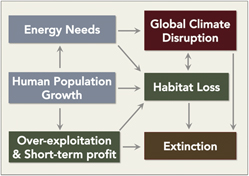Crossref Citations
This article has been cited by the following publications. This list is generated based on data provided by
Crossref.
Williams, Mark
Zalasiewicz, Jan
Waters, Colin N.
Edgeworth, Matt
Bennett, Carys
Barnosky, Anthony D.
Ellis, Erle C.
Ellis, Michael A.
Cearreta, Alejandro
Haff, Peter K.
Ivar do Sul, Juliana A.
Leinfelder, Reinhold
McNeill, John R.
Odada, Eric
Oreskes, Naomi
Revkin, Andrew
Richter, Daniel deB
Steffen, Will
Summerhayes, Colin
Syvitski, James P.
Vidas, Davor
Wagreich, Michael
Wing, Scott L.
Wolfe, Alexander P.
and
Zhisheng, An
2016.
The Anthropocene: a conspicuous stratigraphical signal of anthropogenic changes in production and consumption across the biosphere.
Earth's Future,
Vol. 4,
Issue. 3,
p.
34.
Asmelash, Henok Birhanu
2016.
Falling Oil Prices and Sustainable Energy Transition: Towards a Multilateral Agreement on Fossil-Fuel Subsidies.
SSRN Electronic Journal,
Chen, Qianli
and
Braun, Artur
2017.
Protons and the hydrogen economy.
MRS Energy & Sustainability,
Vol. 4,
Issue. 1,
Palombo, Maria Rita
2018.
Advances in Quaternary Studies: The Contribution of the Mammalian Fossil Record.
Quaternary,
Vol. 1,
Issue. 3,
p.
26.
Žliobaitė, Indrė
2019.
AI minds need to think about energy constraints.
Nature Machine Intelligence,
Vol. 1,
Issue. 8,
p.
335.
Ramanathan, Veerabhadran
2020.
Health of People, Health of Planet and Our Responsibility.
p.
49.
Palombo, Maria Rita
2021.
Thinking about the Biodiversity Loss in This Changing World.
Geosciences,
Vol. 11,
Issue. 9,
p.
370.
Friedemann, Alice J.
2021.
Life after Fossil Fuels.
Vol. 81,
Issue. ,
p.
21.
Kotzé, Louis J.
Du Toit, Louise
and
French, Duncan
2021.
Friend or foe?.
Oñati Socio-Legal Series,
Vol. 11,
Issue. 1,
p.
180.
Jager, Henriette I.
Efroymson, Rebecca A.
and
McManamay, Ryan A.
2021.
Renewable energy and biological conservation in a changing world.
Biological Conservation,
Vol. 263,
Issue. ,
p.
109354.
Raven, Peter H.
and
Wagner, David L.
2021.
Agricultural intensification and climate change are rapidly decreasing insect biodiversity.
Proceedings of the National Academy of Sciences,
Vol. 118,
Issue. 2,
Jager, Henriette I.
Long, Jonathan W.
Malison, Rachel L.
Murphy, Brendan P.
Rust, Ashley
Silva, Luiz G. M.
Sollmann, Rahel
Steel, Zachary L.
Bowen, Mark D.
Dunham, Jason B.
Ebersole, Joseph L.
and
Flitcroft, Rebecca L.
2021.
Resilience of terrestrial and aquatic fauna to historical and future wildfire regimes in western North America.
Ecology and Evolution,
Vol. 11,
Issue. 18,
p.
12259.
Engle-Friedman, Mindy
Tipaldo, Jenna
Piskorski, Natalia
Young, Steven G.
and
Rong, Calvin
2022.
Enhancing environmental resource sustainability by imagining oneself in the future.
Journal of Environmental Psychology,
Vol. 79,
Issue. ,
p.
101746.
Tanner, Armand
Gretz, Mélanie
Spahr, Céline
Senn, Nicolas
and
Fragnière, Augustin
2022.
Santé et environnement.
p.
108.
Makwinja, Rodgers
Mengistou, Seyoum
Kaunda, Emmanuel
and
Alamirew, Tena
2022.
Managing ecosystem services demand under a changing catchment: a case study of Lake Malombe Catchment, Malawi.
GeoJournal,
Vol. 87,
Issue. 6,
p.
5305.
Diken, Gürkan
and
Bahrioğlu, Ergi
2023.
Carbon footprint values as a climate change assessment criterion of the partial harvests of European seabass and meagre in earthen pond aquaculture.
Journal of Water and Climate Change,
Vol. 14,
Issue. 10,
p.
3830.
Akhai, Shalom
and
Abbass, Mahapara
2024.
Nexus of AI, Climatology, and Urbanism for Smart Cities.
p.
325.
Ochieng, Francis Oketch
2024.
A novel data-driven dynamical model for predicting future climate trends.
Modeling Earth Systems and Environment,
Vol. 10,
Issue. 4,
p.
4599.
Anderson, A.B.
Opsahl-Sorteberg, H.G.
Gomes, L.E.O.
Horta, P.
Serrão, E.
Chapman, A.S.
and
Joyeux, J-C.
2025.
Offshore wind farms threaten the endangered Brazilian kelp Laminaria abyssalis: a call for urgent nature-positive action.
Ocean & Coastal Management,
Vol. 267,
Issue. ,
p.
107737.
Wolf, Shaye
Bullard, Robert
Buonocore, Jonathan J
Donley, Nathan
Farrelly, Trisia
Fleming, John
González, David J X
Oreskes, Naomi
Ripple, William
Saha, Robin
and
Willis, Mary D
2025.
Scientists’ warning on fossil fuels.
Oxford Open Climate Change,
Vol. 5,
Issue. 1,
